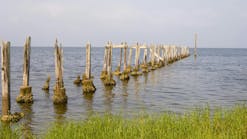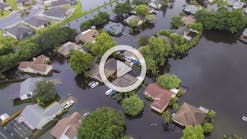The Gulf Hypoxia Task Force, chaired by the U.S. Environmental Protection Agency (EPA), yesterday released its 2008 revised Gulf Hypoxia Action Plan, which identifies efforts to track progress, update the science and adapt actions to reduce nutrients flowing from 31 states into the Mississippi River. Those excess nutrients impair waterways throughout the states and result in an annual dead zone in the Gulf of Mexico.
"We're all committed to improving water quality and reducing nutrient pollution in America's largest watershed," said Benjamin H. Grumbles, EPA's assistant administrator for water. "The science-driven action plan is a road map for real progress through cooperative conservation, interstate collaboration and local innovation."
The revised plan, which is open for public comment until Jan. 4, 2008, includes several improvements over the current action plan, first published in 2001. It increases accountability and specificity for state and federal partners; shifts the lead for nutrient reduction strategies from Mississippi River sub-basin teams to the states; charges federal agencies to prepare complementary federal nutrient reduction strategies for appropriate federal programs and projects; and enhances mechanisms for tracking and reporting.
The revised plan is an outgrowth of new information gained from experience, scientific studies and public comment during the reassessment period. Federal agencies and states within the entire Mississippi/Atchafalaya River Basin have been working together to reduce the size of the dead zone through a collaborative approach, while protecting and restoring human and natural resources of the basin. The solutions must balance environmental, cultural and economic demands to protect coastal fisheries and resources, plus the basin's water quality.
Hypoxia occurs when excess nutrients, primarily nitrogen and phosphorous, trigger excessive algae growth that results in reduced sunlight, loss of aquatic habitat and a decrease in oxygen in the water. Excess nutrients can come from agricultural fertilizers, factory and wastewater treatment plant discharges, runoff from developed land, atmospheric deposition and soil erosion. Shrimp and other benthic communities are unable to escape hypoxic bottom waters, but the full extent of the impact of hypoxia on this nationally significant ecosystem has only begun to be understood.
The size of the dead zone is 20,500 sq km. The goal is to reduce or make significant progress toward reducing the five-year running average to less than 5,000 sq km by 2015. The hypoxic zone in the Gulf of Mexico is the second largest hypoxic zone in the world.
The task force, which is officially known as the Mississippi River/Gulf of Mexico Watershed Nutrient Task Force, leads efforts to promote and support nutrient management and hypoxia-related activities throughout the vast Mississippi River and Gulf of Mexico watershed as well as encourages public participation in the process.
For more information regarding the revised action plan, visit www.epa.gov/msbasin.
Source: U.S. EPA






